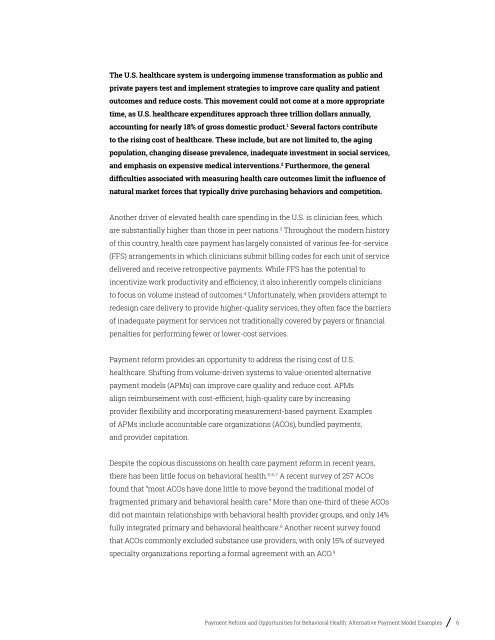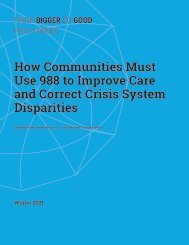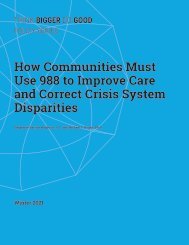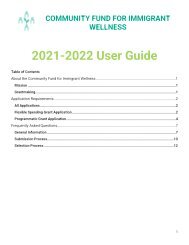Alternative Payment Models
You also want an ePaper? Increase the reach of your titles
YUMPU automatically turns print PDFs into web optimized ePapers that Google loves.
The U.S. healthcare system is undergoing immense transformation as public and<br />
private payers test and implement strategies to improve care quality and patient<br />
outcomes and reduce costs. This movement could not come at a more appropriate<br />
time, as U.S. healthcare expenditures approach three trillion dollars annually,<br />
accounting for nearly 18% of gross domestic product. 1 Several factors contribute<br />
to the rising cost of healthcare. These include, but are not limited to, the aging<br />
population, changing disease prevalence, inadequate investment in social services,<br />
and emphasis on expensive medical interventions. 2 Furthermore, the general<br />
difficulties associated with measuring health care outcomes limit the influence of<br />
natural market forces that typically drive purchasing behaviors and competition.<br />
Another driver of elevated health care spending in the U.S. is clinician fees, which<br />
are substantially higher than those in peer nations. 3 Throughout the modern history<br />
of this country, health care payment has largely consisted of various fee-for-service<br />
(FFS) arrangements in which clinicians submit billing codes for each unit of service<br />
delivered and receive retrospective payments. While FFS has the potential to<br />
incentivize work productivity and efficiency, it also inherently compels clinicians<br />
to focus on volume instead of outcomes. 4 Unfortunately, when providers attempt to<br />
redesign care delivery to provide higher-quality services, they often face the barriers<br />
of inadequate payment for services not traditionally covered by payers or financial<br />
penalties for performing fewer or lower-cost services.<br />
<strong>Payment</strong> reform provides an opportunity to address the rising cost of U.S.<br />
healthcare. Shifting from volume-driven systems to value-oriented alternative<br />
payment models (APMs) can improve care quality and reduce cost. APMs<br />
align reimbursement with cost-efficient, high-quality care by increasing<br />
provider flexibility and incorporating measurement-based payment. Examples<br />
of APMs include accountable care organizations (ACOs), bundled payments,<br />
and provider capitation.<br />
Despite the copious discussions on health care payment reform in recent years,<br />
there has been little focus on behavioral health. 5, 6, 7 A recent survey of 257 ACOs<br />
found that “most ACOs have done little to move beyond the traditional model of<br />
fragmented primary and behavioral health care.” More than one-third of these ACOs<br />
did not maintain relationships with behavioral health provider groups, and only 14%<br />
fully integrated primary and behavioral healthcare. 8 Another recent survey found<br />
that ACOs commonly excluded substance use providers, with only 15% of surveyed<br />
specialty organizations reporting a formal agreement with an ACO. 9<br />
<strong>Payment</strong> Reform and Opportunities for Behavioral Health: <strong>Alternative</strong> <strong>Payment</strong> Model Examples 6

















